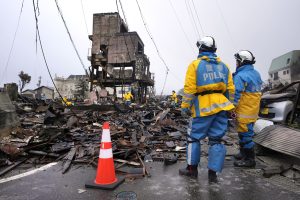On New Years Day 2024, a severe earthquake struck Japan on the Noto Peninsula of Ishikawa Prefecture. The 7.6-magnitude earthquake led to the issuing of a major tsunami warning, the first since the Tohoku earthquake and tsunami in 2011, which triggered the nuclear disaster at the Fukushima power plant. Needless to say, the event brought back painful memories.
More than two weeks later, relief efforts continue. The death toll has now hit 232. Over 100 people are still missing, and more than 28,000 people have been displaced to 403 evacuation centers. There is no denying that Ishikawa faces a grave tragedy.
Yet, it will be a relief to the Japanese government that there is little sense of a political crisis in the mold of 2011. Japanese media outlets are describing the disaster as the Ishikawa Earthquake (jishin), not as the Great Ishikawa Earthquake (dai-shinsai), a title used to describe both the earthquakes in Kobe 1995 and Tohoku 2011.
The scale of these events goes some way to explaining this. The Tohoku disaster caused a staggering 19,759 deaths and the loss of life in 1995 reached 6,434.
However, there is also a deeper sense that these were different types of disasters. The Tohoku earthquake was a natural event, but the consequences of the meltdown at the Fukushima Daiichi nuclear plant were shaped by people.
In 2011, stories about the ferocity of the tsunami were quickly accompanied by questions of human failures exacerbating the tragedy. Why had the sea wall at the nuclear power plant proven inadequate? And why was Fukushima so ill-prepared to evacuate? By all accounts, crisis communication was poor; 57.7 percent of evacuees said that they didn’t know where they were supposed to evacuate to.
What most troubled the public was the idea that this was “a disaster ‘Made in Japan”” – a conclusion that the National Accident Independent Investigation Commission endorsed. The notion that while the nuclear disaster was triggered by a tsunami, its root causes could be found in Japan’s political culture moved people from sorrow to anger.
The Tokyo Electric Power Company (TEPCO), which operated the Fukushima Daiichi nuclear power plant, repeatedly insisted that an earthquake of this historic scale had been “unforeseeable.” The magnitude 9.1 Tohoku earthquake remains the third largest globally on record. Yet reports of a lax regulatory culture, revolving doors between government and industry, and the nuclear lobby’s influence over policy, left many citizens in no doubt that this was an unnatural disaster.
By 2012, anti-nuclear protestors gathered outside the Prime Minister’s Office every Friday in the largest demonstrations that Japan had seen since the 1960s. The protests continued until the onset of the COVID-19 pandemic, albeit in smaller numbers as the years went on.
The Kobe Earthquake in 1995 provoked similar outpourings of anger. In the first session of the National Diet after the earthquake, Prime Minister Murayama Tomiichi struggled to make himself heard over the opposition’s criticisms and jeers. “What do you think management means?” one councilor shouted at the prime minister. “Why didn’t you send in rescue teams immediately from around the country?”
As in 2011, after the Kobe Earthquake the Japanese public quickly concluded that political failures were responsible for the scale of the disaster. Some focused on the slow mobilization of the Japanese Self-Defense Forces; others questioned Japan’s refusal of international aid. Many contrasted the speed with which the Yamaguchi-gumi, Japan’s largest Yazuka group, mobilized to distribute aid with the sluggishness of the state. Still others questioned why 400,000 buildings had failed – concluding that Japan’s building regulations were inadequate.
In contrast to both the Kobe and Tohoku earthquakes, the Ishikawa quake is at present still seen as a natural disaster. It did not trigger a nuclear incident. The plant closest to the epicenter, the Shika plant in Ishikawa, has been offline since 2011 and its operator reports that its cooling systems remain operational. And, so far, the emergency response has been positively received. The rescue of a 90-year-old woman who was trapped for five days has been celebrated internationally.
However, mistakes have been made. A Japan Airlines plane and a coast guard plane headed to the Noto Peninsula collided at Haneda airport, Tokyo, on January 2, killing five members of the coast guard. Moreover, many challenges remain to be addressed. More than 100 people are still missing and there is a need to rehouse the tens of thousands displaced by the earthquake. The crisis may be over, but the disaster is still ongoing.
As the global media moves its attention to other issues, the Japanese state must guard against complacency. The Kobe and Tohoku earthquakes demonstrate how quickly a natural disaster can become a political crisis, when governments are seen to fail the people.

































